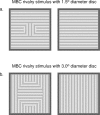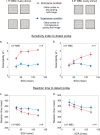Revealing boundary-contour based surface representation through the time course of binocular rivalry
- PMID: 21496462
- PMCID: PMC3090490
- DOI: 10.1016/j.visres.2011.04.005
Revealing boundary-contour based surface representation through the time course of binocular rivalry
Abstract
We varied the surface boundary-contour properties of binocular rivalry (BR) stimuli to measure the rivalry percept as a function of stimulus duration. Experiment 1 compared perception from BR stimuli with monocular boundary contour (MBC) and binocular boundary contour (BBC). We found global dominance is achieved with stimulus duration as short as 30ms for the MBC rivalry stimuli, whereas it takes more than 150 ms for the BBC rivalry stimuli. This shows that global dominance can occur rapidly in the absence of a corresponding boundary contour in one half-image. Experiment 2 measured the detection of a monocular Gabor probe located centrally on a 1.5° versus 3.0° MBC rivalry stimulus. We found reliable binocular suppression is observed earlier with the 1.5° MBC stimulus, presumably because of the probe being spatially located nearer to the boundary contour. These findings, in conjunction with those in Su et al. (2011), support the notion that the representation of the dominant surface begins at the MBC and spreads toward the center of the image.
Copyright © 2011 Elsevier Ltd. All rights reserved.
Figures




Similar articles
-
The magnitude and dynamics of interocular suppression affected by monocular boundary contour and conflicting local features.Vision Res. 2010 Sep 24;50(20):2037-47. doi: 10.1016/j.visres.2010.07.003. Epub 2010 Jul 17. Vision Res. 2010. PMID: 20624411 Free PMC article.
-
Binocular rivalry and surface-boundary processing.Perception. 2006;35(5):581-603. doi: 10.1068/p5489. Perception. 2006. PMID: 16836052
-
Preserved gain control for luminance contrast during binocular rivalry suppression.Vision Res. 2004 Dec;44(26):3065-71. doi: 10.1016/j.visres.2004.07.011. Vision Res. 2004. PMID: 15474579
-
Stimulus flicker alters interocular grouping during binocular rivalry.Vision Res. 2007 Jan;47(1):1-7. doi: 10.1016/j.visres.2006.09.007. Epub 2006 Nov 2. Vision Res. 2007. PMID: 17083956
-
The monocular-boundary-contour mechanism in binocular surface representation and suppression.Perception. 2008;37(8):1197-215. doi: 10.1068/p5986. Perception. 2008. PMID: 18853556 Free PMC article. Clinical Trial.
Cited by
-
A binocular perimetry study of the causes and implications of sensory eye dominance.Vision Res. 2011 Dec 8;51(23-24):2386-97. doi: 10.1016/j.visres.2011.09.012. Epub 2011 Oct 2. Vision Res. 2011. PMID: 21989227 Free PMC article.
-
Evidence in Support of the Border-Ownership Neurons for Representing Textured Figures.iScience. 2020 Aug 21;23(8):101394. doi: 10.1016/j.isci.2020.101394. Epub 2020 Jul 21. iScience. 2020. PMID: 32755803 Free PMC article.
-
Further support for the importance of the suppressive signal (pull) during the push-pull perceptual training.Vision Res. 2012 May 15;61:60-9. doi: 10.1016/j.visres.2012.01.003. Epub 2012 Jan 18. Vision Res. 2012. PMID: 22273998 Free PMC article.
-
Sensory Eye Dominance: Relationship Between Eye and Brain.Eye Brain. 2020 Jan 20;12:25-31. doi: 10.2147/EB.S176931. eCollection 2020. Eye Brain. 2020. PMID: 32021530 Free PMC article. Review.
-
Understanding attentional modulation of binocular rivalry: a framework based on biased competition.Front Hum Neurosci. 2011 Dec 2;5:155. doi: 10.3389/fnhum.2011.00155. eCollection 2011. Front Hum Neurosci. 2011. PMID: 22144958 Free PMC article.
References
-
- Alais D, Blake R. Interactions between global motion and local binocular rivalry. Vision Research. 1998;38:637–644. - PubMed
-
- Blake R. A neural theory of binocular rivalry. Psychological Review. 1989;96:145–167. - PubMed
-
- Blake R, Westendorf DH, Overton R. What is suppressed during binocular rivalry? Perception. 1980;9:223–231. - PubMed
-
- Brainard DH. The Psychophysics Toolbox. Spatial Vision. 1997;10:433–436. - PubMed
-
- Caputo G. Texture brightness filling-in. Vision Research. 1998;38:841–851. - PubMed
Publication types
MeSH terms
Grants and funding
LinkOut - more resources
Full Text Sources

